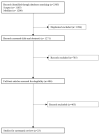Knowledge, Behaviour and Attitudes Related to Sun Exposure in Sportspeople: A Systematic Review
- PMID: 36011808
- PMCID: PMC9407896
- DOI: 10.3390/ijerph191610175
Knowledge, Behaviour and Attitudes Related to Sun Exposure in Sportspeople: A Systematic Review
Abstract
People who practice outdoor sports have an increased risk of skin cancer as they are exposed to high doses of ultraviolet (UV) radiation. Recent studies have shown that in many athletes, sun protection behaviours are inadequate, with the risk that this entails. The aim of this review is to collect the information published to date about the knowledge, attitudes and habits of athletes in relation to sun exposure and its risks. A systematic review was conducted using PubMed and Embase with the search algorithm "(skin cancer OR melanoma) AND (exercise OR sport OR athletes)". All studies analysing the knowledge, attitudes and habits of photoprotection in athletes were included. A total of 2,365 publications were found, of which 23 were selected, including a total of 10,445 sportspeople. The majority of participants declared their voluntary intention to tan and stated that the sun made them feel better, although they also showed concern about possible damage associated with UV radiation. In most studies, less than half of the participants made adequate use of photoprotective measures. In general, most athletes had a high level of knowledge regarding the risk of skin cancer associated with sun exposure. In conclusion, most athletes are aware of the risks associated with UV radiation but do not make adequate use of photoprotective cream. New training programs on photoprotection could help improve athletes' photoprotective behaviour, reducing the incidence of skin cancer and precancerous lesions in this population.
Keywords: exercise; skin cancer; sport; sun exposure; sun protection; sun-related behaviour; ultraviolet radiation.
Conflict of interest statement
The authors declare no conflict of interest.
Figures
Similar articles
-
Sun exposure and protection habits in transplant athletes: An international survey.Photodermatol Photoimmunol Photomed. 2022 Jul;38(4):365-372. doi: 10.1111/phpp.12755. Epub 2021 Dec 8. Photodermatol Photoimmunol Photomed. 2022. PMID: 34817897
-
Do Athletes Practicing Outdoors Know and Care Enough About the Importance of Photoprotection?Acta Dermatovenerol Croat. 2020 Jul;28(1):41-42. Acta Dermatovenerol Croat. 2020. PMID: 32650851
-
Sun-related knowledge and attitudes of primary and secondary schoolchildren in western Switzerland.Eur J Cancer Prev. 2017 Sep;26(5):411-417. doi: 10.1097/CEJ.0000000000000279. Eur J Cancer Prev. 2017. PMID: 27749495
-
Outdoor sports and skin cancer.Clin Dermatol. 2008 Jan-Feb;26(1):12-5. doi: 10.1016/j.clindermatol.2007.10.001. Clin Dermatol. 2008. PMID: 18280899 Review.
-
Ultraviolet radiation.Chronic Dis Can. 2010;29 Suppl 1:51-68. Chronic Dis Can. 2010. PMID: 21199599 Review.
Cited by
-
A prospective study analyzing the use of free public sunscreen dispensers.Can J Public Health. 2025 Feb;116(1):140-145. doi: 10.17269/s41997-024-00946-x. Epub 2024 Oct 24. Can J Public Health. 2025. PMID: 39446297
-
Effect of video-based intervention on the sun protective beliefs and behaviours of student athletes.Skin Health Dis. 2023 Dec 1;4(6):e318. doi: 10.1002/ski2.318. eCollection 2024 Dec. Skin Health Dis. 2023. PMID: 39624742 Free PMC article.
-
The need to (climate) adapt: perceptions of German sports event planners on the imperative to address climate change.Front Sports Act Living. 2024 Dec 23;6:1505372. doi: 10.3389/fspor.2024.1505372. eCollection 2024. Front Sports Act Living. 2024. PMID: 39763488 Free PMC article.
-
Knowledge and Risk Perception Regarding Keratinocyte Carcinoma in Lay People: A Systematic Review and Meta-Analysis.Healthcare (Basel). 2025 Aug 6;13(15):1912. doi: 10.3390/healthcare13151912. Healthcare (Basel). 2025. PMID: 40805951 Free PMC article. Review.
-
Sun protection knowledge and behaviors of agricultural workers in Turkey: a cross-sectional study.BMC Public Health. 2024 Sep 20;24(1):2571. doi: 10.1186/s12889-024-20121-8. BMC Public Health. 2024. PMID: 39304853 Free PMC article.


